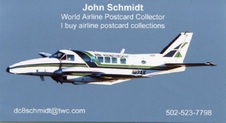
1
Air Kentucky B-99
As first Eastern, then Ozark abandoned Owensboro, Ky. FBO Owensboro Aviation launched Air Kentucky in 1974 with 1 new Beech B-99 providing service to Louisville as well as other Ky destinations. For years I flew N12AK almost weekly. It seemed appropriate to use on my card.
| 
2
Air Kentucky Ramp
Other 99s were added to the fleet, still based in Owensboro. Flights served Bowling Green, Clarksville and Nashville as well. Despite some success, the airline became an Allegheny Commuter in 1980. This is an Owensboro airport card published by IAWP.
| 
3
Air Illinois DHC-6
Air Illinois began service in 1970 providing replacement service from Carbondale, Springfield, and other Illinois cities to Chicago. DHC-6s as shown on this Air Illinois issue operated the services.
| 
4
Air Illinois HS-748
The airline grew rapidly, reaching to Memphis and Arkansas, acquiring 2 HS-748s for Chicago flights that had the specific capability of operating out of Downtown Meigs Field.
By 1982 the airline was operating BAC-111 jets, and serving 6 states before the crash of a 748 led to the grounding and destruction of the airline. Card is an oversized Air Illinois Issue.
| 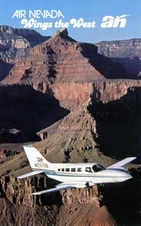
5
Air Nevada Cessna 402 #1
Air Nevada was launched in 1978 to provide flights from Las Vegas to Grand Canyon airport
|

6
Air Nevada Cessna 402 #2
Schedules were published through 1997, but by early 1998 the airline was gone.
| 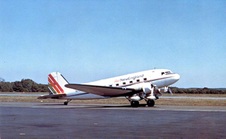
7
Air New England DC-3
Air New England, like many commuters was launched with Beech 18s. Service began in 1970 to Cape Cod destinations, but quickly expanded to Augusta, Portland and New York City by the end of the year.
In 1971 the first of 6 DC-3s, shown on this Mary Jayne's issue, was added, giving the airline much of the appearance of the Local Service Airlines.
"This particular view was tak..."
"This particular view was tak..."
View Comments...
| 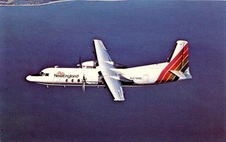
8
Air New England FH-227
Beech 99s and Twin Otters supplemented the DC-3s in the 1970s and in 1975 the airline was certified by the CAB. FH-227s were added in 1975 as shown on this nice Aviation World issue, and routes extended west to Cleveland and south to Baltimore, but the code sharing revolution was underway, and Air New England, like so many others could not survive. It shut down in October 1981.
"ANE acquired this FH-227 via..."
View Comments...
| 
9
Air Oregon Metro
Air Oregon was a short lived Commuter which was created in 1978, and quickly developed an extensive network of 15 Oregon cities plus Boise and Seattle. Flights were started with Navajos, but the Metro became the primary aircraft, as shown on this IAWP issue.
In 1982 the airline was merged into Horizon, substantially expanding Horizon's route structure.
| 
10
Air Vermont Beech 99
Another short lived commuter was Air Vermont. Created in 1981, Air Vermont served 11 New England Cities plus Wilkes Barre and Washington DC with new Beech C-99s, delivered in 1983.
Unfortunately the Airline was unable to compete as an independent, and ceased operations in early 1985.
Card is a Mary Jayne's issue.
|

11
Atlantic Southeast DHC-7
Atlantic Southeast was launched in 1979 with a Twin Otter serving Columbus, Ga. From Atlanta. New destinations and Emb. 110s were added in 1980. Growth was explosive, and in 1982 the DHC-7, as shown on this Mary Jayne's issue, was added, as the airline was serving Montgomery and Greenville Spartanburg in addition to the Carolinas and Georgia.
| 
12
Atlantic Southeast Brasilia
In 1983 Southeastern Airlines was acquired, essentially doubling the airline's reach. But 1984 saw the addition of Atlantic Southeast to Delta's network. The airline retained some of its identity, as on the newly delivered Emb.120s. Some years later, Delta colors replaced the familiar ASA livery.
| 
13
Atlantis (US) Metro
Atlantis Airlines was formed in the Carolina's in 1978, operating Navajos. By 1980 Twin Otters were serving the routes, which included Myrtle Beach, Florence and Augusta. In 1981 the Metros replaced the Twin otters.
| 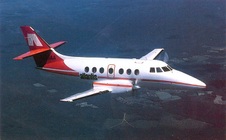
14
Atlantis (US) J-31 Jetstream
By 1983 Atlantis was flourishing, serving destinations in the Carolinas, Georgia, and Tennessee. The J-31 Jetstream, as shown on this Mary Jayne's Issue were introduced, and soon were repainted in Eastern colors, as Atlantis became an Eastern Express carrier.
| 
15
Big Sky Metro
Big Sky was formed in 1978, initially replacing Frontier service to a number of Montana cities with 3 Jetstreams, which were quickly replaced by Swearingen Metros as shown on the above Big Sky Issue. By 1985 Big sky operated to 14 cities from its Billings hub, but shortly after joined the code share roller coaster with Northwest.
After a 1990 bankruptcy Big Sky re-emerged as an independent growing through mergers and adding Beech 1900s. But after a brief attempt as a Delta Connection it died in 2008
|

16
Cape Air Cessna 402 #1
Cape Air is the ultimate survivor. Created 1n 1989 as a Nantucket shuttle the airline has persisted, and still operates a Nantucket Airlines entity.
| 
17
Cape Air Cessna 402 #2
A rather ingenious pattern of disconnected operations began, by undertaking essential air service contracts using the valueless Cessna's and receiving Federal subsidies.
| 
18
Cape Air Cessna 402 #3
Now the airline has mini hubs feeding United, American and Jet Blue at locations from New York to Guam to the Caribbean, and collecting in excess of $30,000,000 in subsidies annually.
| 
19
Chaparral Beech 99
Chaparral was born in 1976, featuring Navajos and these colorful Beech 99s flying from Abilene to Houston and Dallas.
| 
20
Chaparral CASA 212
The CASA 212 was added to the fleet in 1981, serving 5 destinations in Texas plus Alexandria, La.
|

21
Chaparral Gulfstream 1C
Chaparral made a big jump in 1982 acquiring a Gulfstream 1, and adding additional aircraft in 1985 and 86. Flights from Abilene served Dallas, Alexandria, Houston, Austin San Antonio and Laredo. However, in 1987 Chaparral became an American Eagle and disappeared by 1990. The card is a Chaparral issue.
| 
22
Chicago Express J-31 Jetstream
One of the last commuters, Chicago Express was formed in 1993, to provide access to Chicago from mid sized Midwestern cities. Operations were performed by J-31 Jetstreams, as shown on this Chicago Express issue.
| 
23
Chicago Express Saab 340 #1
In 1996, the first Saab 340s were delivered, and an affiliation with American Transair resulted in code sharing as ATA Connection.
| 
24
Chicago Express Saab 340 #2KCF
The ATA Connection resulted in the purchase of Chicago Expess in 1999. The 340s were operating in this striking livery, shown on this rare airline issue provided by Kuo-Ching Fu.
| 
25
Colgan Shorts SD-330
Colgan was launched in 1971 in Manassas Virginia. Beech 99s served the early routes, some of which were replacements for Piedmont Airlines service. As the airline expanded to Washington, Raleigh Durham, and Binghamton, demand justified the acquisition of the New SD-330 in 1977, as shown on this Aviation World issue.
|

26
Colgan Beech 1900C
In 1983 the first Beech 1900 was added, and by 1984 Colgan's fleet included 5 Beech 99s, 3 1900s and 2 SD-330s. But in 1985 Colgan became a New York Air code share airline. Their 1900 and SD-330 are shown on New York Air Connection cards. After a short stint with Presidential in 1986, it was relaunched as an independent, in 1991, then started the code share roller coaster again in 1999. It officially died in 2012, long after the original death in 1985.
The card is a Mary Jayne's issue.
| 
27
Comair Bandeirante
Comair, perhaps the most spectacular commuter success story, started humbly in 1977, operating Navajos on short hops out of Cincinnati. Even more amazing is that the airline survived an early fatal crash in 1979. By 1980, the airline began to add Bandeirantes to its fleet, as shown on this Comair issue.
| 
28
Comair SD-330
Busier segments were operated by 3 Shorts SD-330 airliners, acquired in 1981, introducing cabin service to Comair routes.
Card is a Comair issue produced by Aviation World.
| 
29
Comair Metro
As routes and traffic expanded, a fleet of Metros was acquired, adding both speed and additional capacity to the fleet.
| 
30
Comair Saab 340 #2
The creation of a Delta hub in Cincinnati opened the door to a code share deal with Delta. So, in 1984 Comair began receiving Saab 340s as shown on this Saab issue, and began a period of explosive growth in which the airline retained its identity, but filled a larger role with Delta.
|
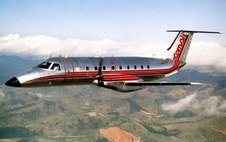
31
Comair Brasilia
In 1986 Delta purchased 20% of Comair's stock and shortly thereafter The Embraer Brasilias were added to the fleet. By 1993 the CRJs were added, and finally, the Comair livery was discarded. Delta purchased the remaining stock in 1999. A series of reorganizations and gross mismanagement contributed to the death of this now colossal feeder airline, which shut down in 2012
| 
32
Coral Air Nomad
Coral Air was formed in the US Virgin Islands in 1980. Flights were operated to San Juan, Tortola, St Croix and St. Thomas, using GAF Nomad, as shown in this Coral Air issue, Bandeirante and Twin Otters. Financial troubles started early in 1982, and an acrimonius bankruptcy led to the dissolution of the airline in 1985.
| 
33
Denver Air Connection Metro
Denver Air Connection is a modern day commuter, a division of Key Lime Air. Flights were begun in 2011 using 19 seat Metros to Grand Junction. The airline now flies to Sheridan and Riverton Wyoming, using DO-328 Jets, as well as Emb-126s. Card issued at AI international in Denver.
| 
34
Dolphin Bandeirante #1 KCF
Unlike most of the struggling commuters, Dolphin Airways was launched in 1981 with a fleet of new Embraer Bandeirante aircraft, serving 16 Florida cities.
The airline appeared to be ready to dominate Florida service, but was voluntarily shut down in 1984, apparently due to some investor conflicts. The card is an Embraer issue by courtesy of Kuo-Ching Fu.
| 
35
Eastern Caribbean Navajo KCF
Eastern Caribbean Airways was formed in 1974, operating Beech 18s and Navajos. Services were to St. Thomas, St. kitts , and St. Croix. The airline was known for a strange disappearance of one of their Navajos, which disappeared after clearance to land at St. Thomas, never to be found.
The airline shut down in 1980.
This rare airline issue is by courtesy of Kuo-Ching Fu.
|

36
Empire Navajo
Empire Airlines, formed in 1976, was one of the most successful Commuters. Initially based at Oneida County airport, the airline began with Navajos, as shown on this IAWP issue.
| 
37
Empire Metro
By 1978, 2 Metros had joined the fleet and services covered Utica-Rome, Boston, Buffalo, Hartford, White Plains, and the 3 NYC Airports. Ultimately 5 Metros were operating.
| 
38
Empire F-28-4000 #1
The first F-28-4000, as shown on this Empire issue, was delivered in 1980, and Empire began a hub operation in Syracuse adding numerous destinations.
| 
39
Empire F-28-4000 #2
By 1981 routes reached Montreal , and Washington DC. Utica-Rome remained an important location, as additional F-28s were added. Card is an Oneida County Airport Issue.
| 
40
Empire F-28-4000 #5 KCF
By 1984, Empire was a large regional Airline, reaching Detroit and Cleveland on the west, Boston, Providence, and Burlington on the east, and adding Ottawa in Canada.
In 1985, Piedmont acquired the thriving airline, ending a very successful commuter operation.
This oversized Empire Issue by courtesy of Kuo-Ching Fu.
|

41
Exec Express DO-228
Exec Express was formed in 1985 in Stillwater, OK, picking up some essential air service routes, with 3 Navajos.
Four DO-228s were acquired in 1987 to accommodate growth from a new Ft. Worth Hub.
Card is a Mary Jayne's issue
| 
42
Exec Express DO-228 #2 KCF
It's rare to see an American commuter flying over Herrenchiemsee in Bavaria. This one was captured, for a Dornier Issue of the airliner. Sadly, they were repossessed after the 1988 chapter 11 bankruptcy of Exec Express. Card by courtesy of Kuo Ching Fu
| 
43
Freedom Convair 580 #1
Freedom Airlines was created in 1980 by Jerry Winston, who was successfully operating Commuter Airlines of Binghamton, NY. He had acquired 5 ex Allegheny Convair 580s, and reached an agreement with United to operate feeder flights to Cleveland.
A year later, United reneged on the deal, but the airline continued operating and expanded to include a large network which included most of Commuter's operation. The airline ceased operations as a result of Winston's death in 1984.
The card is an IAWP issue.
| 
44
Grand Metro
Grand Airways was launched in 1980 using Cessna 402s to shuttle passengers to Grand Canyon. Scheduled services began in 1989 from Southern California to Las Vegas and Grand Canyon Airport using new Metro IIIs. Card is an airline issue, in my view, the best Metro card ever issued.
| 
45
Grand DC-9-30
In 1994 Grand took the bold step of starting DC-9-30 services from Las Vegas to destinations in California and Texas, and ceased the Metro operations. The effort was not successful and the airline shut down in January 1996
|

46
Gull Air Cessna 402
Gull Air, like PBA and others was established to serve Cape Cod destinations in 1975. Also, like PBA, Gull Air launched a Florida system to offset seasonal declines in the North
By 1986 The airline was serving the Cape from Hartford and Boston, and serving 9 destinations in Florida and the Bahamas with Cessna 402s, as shown on this Gull Air issue, and also CASA 212s.
Sadly the airline shutdown in March 1987.
| 
47
Hammonds Air Bandeirante KCF
| 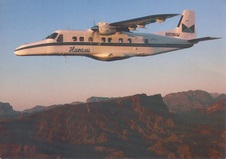
48
Havasu DO-228 #1 KCF
Lake Havasu Air Service,later identified as Havasu Airlines, was launched in 1974 to connect Lake Havasu City with Las Vegas. Flights operated with Piper Navajos until 1986, when a DO-228 was acquired. The airline was connecting with America West at Las Vegas and Phoenix, but ceased operations in 1988. The card is a Dornier Issue, by courtesy of Kuo-Ching Fu.
| 
49
Holiday DHC-6
Holiday Airlines, based in Newark, was established in 1979, to serve the Cape and Atlantic City from Newark, with Piper Navajos. By 1981, services had evolved to cover Allentown, Reading, and Harrisburg, as well as Baltimore. Twin Otters were added in 1983, as shown on this Holiday issue. In its latter years the Airline served Trenton, Hartford , Providence and Martha's Vineyard from Newark, The Twin Otters were replaced with Beech 1900s in 1989, but by December the Airline was bankrupt.
| 
50
Horizon Metro #2
Horizon Air was created in 1981 in Seattle, Beginning with flights from Yakima and Pasco to Seattle. Routes were quickly expanded in 1982 with the acquisition of Air Oregon, and a year later, Transwestern of Utah. The first Metros actually came from Air Oregon, but shown on this Horizon issue is the first new Metro delivered in 1983.
|
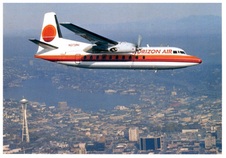
51
Horizon F-27
Horizon actually launched service with this ex-Quebecair F-27. The F-27s operated until 1987, providing cabin service on the busier routes. Horizon's routes reached as far east as Grand Junction, and 23 cities were served. The card is a Horizon issue.
| 
52
Horizon F-28-1000 #1
In 1984 Horizon offerred a IPO to raise capital, and acquired their first F-28, an ex - Air Ivoire 1000 model which ultimately led to a total of 33, operating well into the 2000s. The year 1985 saw Horizon ordering the DHC-8 and shortly after helping launch the DO-328.
Horizon also began code sharing with United, which Alaska stopped by buying the airline in 1986.
Card is an AeroGem issue
| 
53
Horizon DO-328
After the Alaska acquisition, Horizon adopted a new livery compatible with Alaska but maintaining a separate identity. Horizon took delivery of 12 new 328s, but disposed of them in favor of the DHC-8s.
Card is a Horizon issue.
| 
54
Horizon DHC-8-300
Horizon has made great use of the DHC-8s, and continue to operate a large fleet. The separate identity was maintained until 2011, when Alaska took over all phases of operation.
| 
55
Iowa Bandeirante
Iowa Airways was started in October 1985, essentially replacing American Central which was shut down after a crash. The airline connected a number of Iowa cities with Chicago Midway, using ex Tennessee aircraft, and by 1988 was established as a Midway Connection.
The card is an Iowa Airways issue, using the Tennessee Airways image.
|

56
L'Express Beech 1900C
L'Expess was formed in 1989, as a subsidiary of Reed Industries, specifically serving Louisiana destinations. But by 1990, services extended to Houston, Little Rock, Birmingham and Mobile, with a fleet of 9 Beech C-99s. Plus 3 new 1900s, as shown on this outstanding L'Express issue.
In July of 1991, the airline suffered a crash of a Beech 99 at Birmingham, from which the already distressed airline could not recover. The airline shut down in February 1992.
| 
57
Lone Star Metro #1KCF
Exec Express was reborn as Exec Express II in 1988. I believe in 1991 the airline rebranded itself as Lone Star Airlines, with delivery of Swearingin Metros. By 1993 routes extended east as far as Terre Haute Indiana.
Card is an airline issue by courtesy of Kuo-Ching Fu
| 
58
Lone Star DO-328
The DO-328 as shown in this splendid Lone Star issue, were added in 1994 and 1995. Lone Star was operating flights into Mexico, as well as Texas, Oklahoma, Missouri, and Arkansas. In 1996 the airline was acquired by Peak International dba Aspen Mountain, went into decline and was bankrupt by 1998
| 
59
Marco Island Beech 99
Marco Island Airways was created by Deltona Corporation to provide air service to the development and surrounding community. Flights were started in 1972 from Miami to Marco Island using Beech 99s, as shown on this rare Marco Island Issue.
| 
60
Marco Island Martin 404
Demand quickly exceeded capacity of the 99s, and ex Southern Airways Martin 404s assumed the route, expanding to Tampa in 1980. In 1981 the airline began a code share arrangement with Air Florida, and Marco Island's titles disappeared. The airline was sold to PBA in 1984.
|
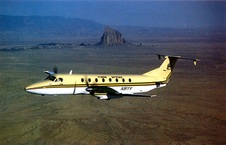
61
Mesa Beech 1900C
Mesa Airlines began humbly enough, as Mesa Air Shuttle in 1980, from Farmington to Albuquerque and Denver. Piper Navajos were replaced by Beech 99s as routes grew, and by 1987 Mesa was operating 11 aircraft including the Beech 1900C as shown on the above Mary Jayne's Issue.
| 
62
Mesa Beech 1900D
The first code share began in 1989, and growth through this mechanism has been unparalleled. Independent operations continued, and Mesa was a launch customer for the 1900D shown on this Mesa issue from 1999. The last published Mesa independent schedule was published in 1999, but now Mesa is an enormous code share operator with a huge fleet of regional jets.
| 
63
Mesaba Beech 99
Mesaba Airlines was formed in 1973, replacing North Central on a number of routes, and operating Cessna 421 equipment and Beech 99s as shown on this Mesaba issue. By 1982 the airline was serving 12 destinations in Minnesota, South Dakota and Iowa. In 1983 the airline became a code share operator with Republic, an grew to a huge operation as a Northwest Airlink.
| 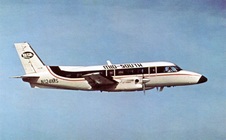
64
Mid South Bandeirante
Mid South was launched in North Carolina in 1975, operating light aircraft to North Carolina destinations from Pinehurst. By 1979 Navajos were operating and in 1980 the first Bandeirante as shown on this Aviation World issue, was delivered. By 1984 the airline was serving Washington and Richmond as well as 6 North Carolina Destinations. But in 1984 the airline was acquired by Air Virginia
| 
65
Nevada DC-3
Nevada Airlines was created in 1971, operating Beech 18s from Las Vegas to Reno with intermediate stops. In 1979 scheduled and charter flights were operated by DC-3 and a Martin 404 had been added. Unfortunately the Martin crashed on departure from Grand Canyon Airport. The airline was grounded by the crash in 1980 although no violations were noted.
Card is a Mary Jayne's issue.
|

66
New York Air (Commuter) Emb.110 KCF
| 
67
Oahu & Kaui Cessna 402 KCF
Oahu & Kaui Airlines, formed in 1975, provided service to Lihue, and apparently brought buyers to the Princeville resort community on Kaui. The airline operated Cessna 402s as shown on this very rare airline issue, until acquired by Air Hawaii in June 1980.
Card provided by Kuo-Ching Fu.
| 
68
Pioneer (New) Beech 99 #2
Pioneer Airlines was launched in 1977 operating from Denver to several Nebraska towns. A n association with Frontier led to the assumption of some Frontier routes with Beech 99s as shown on this IAWP card.
| 
69
Pioneer (New) Metro #1
In 1981 the speedy Metros were introduced to the expanding route system,that included 17 cities in 5 states. This nice view is a Pioneer issue from 1982.
| 
70
Pioneer (New) Metro #2
In 1983 the airline became a Continental Commuter, serving 21 cities from the Denver hub. Continental reneged on the agreement in 1986, and the airline went out of business. This nice card, provided by Kuo-Ching Fu is an unidentified issue.
|

71
Precision DO-228
Precision Airlines actually formed at North Springfield Vermont as a cargo carrier operating Beech 18s for the Machine tool industry. By the late 70s the airline began operating Navajos and later, Twin Otters, on a small network connecting northern New England with Boston.. As the airline prospered, in 1983, 9 New England cities were connected to Boston and NYC, and new Beech C-99s were added. By 1984 DO-228s as shown on this Dornier issue were added.
But in 1986 Precision became a code share carrier with Eastern, then Northwest, and upon Northwest's termination of the agreement the airline ceased operations and bankrupted.
| 
72
Rainbow Cessna 402 #1
Rainbow originally flew from Bridgeport to the Cape Cod islands with Cessna 402s. It later, (1973-4), operated from Keene and Nashua New Hampshire to Hartford and Boston. The card is a Rainbow issue.
| 
73
Rio Beech 99
Rio Airways emerged in 1971, as Hood airways acquired the assets and Name of an earlier Rio Airways. A small operation consisting of Killeen, Temple, Wichita Falls and Dallas was served by Beech 99s, the first of which was received in 1971 as shown on this excellent Rio Issue.
| 
74
Rio DHC-6
In 1976, DHC-6 Twin Otters, as shown on this Rio issue, began to supplement the Beech 99 fleet, as the route map added Waco. By 1978, Houston and College Station were added.
| 
75
Rio Metro
Late 1978 and 1979 resulted in explosive growth, as the airline added Little Rock, Texarkana, Wichita Falls, Bryan, Hot Springs, San Angelo and Memphis to the System. The Metros, as shown on this Rio issue began arriving in 1980
|

76
Rio DHC-7
By 1983 Rio had became a major regional airline, with routes extending from Jackson, TN, Greenville MS, and Jonesboro AR to the west of Texas. DHC-7s as shown on this outstanding Rio issue had brought comfort and cabin service to Rio Routes. A brief effort as a Delta Connection carrier materialized in 1984, and the airline was sold in Sept. 1986. The Delta Connection ceased in December, and the airline filed Bankruptcy in Feb 1987.
| 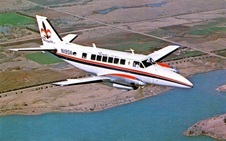
77
Royale Beech 99
Royale Airlines was started in Shreveport in April of 1970, operating 2 new Beech 99A airliners, as shown on this splendid Royale issue. Early routes included Houston, New Orleans, Lake Charles, Lafayette and Fort Polk. By 1976, Monroe, Alexandria and Baton Rouge we're added.
| 
78
Royale Emb. 110 #1 KCF
By 1983 Royale was operating a fleet of 12 Embraer Bandeirantes, as shown on the above Embraer issue, adding Gulfstream 1 airliners, and serving a greatly expanded network. Routes reached from Laredo to Memphis, and New Orleans to Dallas.
A relationship with Continental included the operation of DC-9s from Houston to Brownsville, and a code sharing agreement, but the airline filed Chapter 11 in 1987, and finally shut down in 1989.
| 
79
San Juan Cessna 402 #1
San Juan's roots go back to 1947, with the creation of Island Sky Ferries, which provided air service to Bellingham from the various San Juan Islands. A consolidation of 6 airlines united with Island Sky Ferries to form Puget Sound Airlines in 1969. Puget Sound lasted only a year, but was reformed as San Juan, without interruption.
| 
80
San Juan Cessna 402 #2
Aztecs and single engine aircraft had served the routes but by the early 1980s, Britten Norman Islanders were operating the routes. Later the 402s appeared, as shown on this vintage Smith Western issue.
|
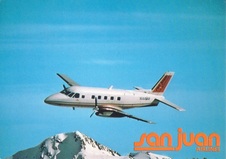
81
San Juan Emb. 110 #1 KCF
By the mid 1980s, the airline was flying to 9 destinations from Seattle, as well as the islands, and interline connections were made at Seattle with major airlines. Beech 99s and later Embraer Bandeirantes as shown on this San Juan Issue, were introduced. But new competitive pressures forced the shutdown in 1989. A new San Juan has since been re-launched.
(card by courtesy of Kuo-Ching Fu)
| 
82
San Juan (New) Cessna 208 #1KCF
After the demise of the original San Juan, a new San Juan was formed in 2002 offering scheduled services with Cessna 208s, as well as charter and sight-seeing flights. This schedule card was provided by Kuo-Ching Fu.
| 
83
Simmons SD-360
Simmons, created in Michigan in 1980, was serving 8 Michigan destinations by 1981, with a fleet of Embraer Bandeirantes. In 1983 and 84, SD-360s were added to the fleet, and routes extended through Wisconsin, Indiana, Ohio, and Illinois. In early 1985 Simmons became a Republic Express carrier, and now remains an enormous operator for American.
The card is a Mary Jayne's issue.
| 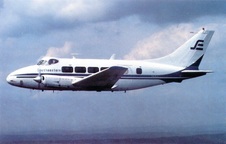
84
Southeastern Commuter Dove
Southeastern Commuter was launched in 1975, initially with Islanders, which were replaced in 1977 by DeHavilland Doves, as shown on this Mary Jayne's issue. Auburn AL to Atlanta was the primary route until 1980, when Gadsden and Rome, GA were added.
| 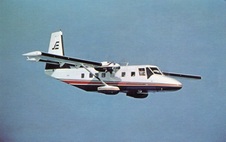
85
Southeastern Commuter Nomad
The airline sold in 1982, and dropped the Commuter from the Titles. New GAF Nomads, shown on this Aviation World issue, were ordered and substantial expansion took place, with routes reaching Huntsville, Memphis, Nashville, Tuscaloosa and Dothan AL.
|

86
Southeastern Commuter EMB-110 #1 KCF
Six new Bandeirantes were also added to the Southeastern fleet in 1982, and a hub was created in Memphis, adding flights to destinations deserted by Republic. In 1983, however, Atlantic Southeast acquired the Airline.
The card is a Embraer issue by courtesy of Kuo-Ching Fu.
| 
87
Sunbelt SD-360
Sunbelt Airlines of Camden Arkansas, originated as Jamaire in January, 1979. Starting with Cessna 402s, the airline spread its wings and adopted the title of Sunbelt in April 1982. Bandeirantes joined the fleet and 2 SD-360s as shown on the above IAWP issue, were operating in 1984. Routes reached Memphis, New Orleans and Dallas, from 10 other cities in 6 states. The airline ceased operations in October 1984
| 
88
Sunbird (US) Cessna 402
Sunbird began operations in November 1979, with Cessna 402s, as shown on this Aviation World card. Original destinations were Charlotte, Hickory, Raleigh Durham, and Rocky Mount.
| 
89
Sunbird (US) Beech 99
In 1981, Beech 99s were introduced, as shown on this very nice Aviation World issue. Routes were extended to Atlanta and Knoxville, as well as other NC cities. The year 1983 saw expansion to Richmond, & Baltimore, but in late 1984 the airline restructured to a central hub at Charlotte. In 1985, Sunbird, "the Carolina Connection" became a Piedmont Commuter.
| 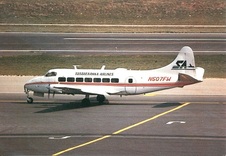
90
Susquehanna Heron
Susquehanna Airways was launched in 1978 by Bernard Forde (originally as Forde Air). Original service was by Piper Aztec from Sydney, NY to Syracuse. By 1983, services focused on Binghamton, with flights to NYC airports and Boston. Riley Herons, as shown on this rare Avimage issue were acquired to service the expanding routes.
By 1985, the airline was serving Boston, Chicago and NYC from Binghamton, as well as Wilkes Barre and Sidney. Unfortunately (2) 1984 crashes of Aztecs near Sydney resulted in the grounding of the airline. Three Herons and the Binghamton NYC route were sold to Ransome, and the airline shut down in September 1985.
|
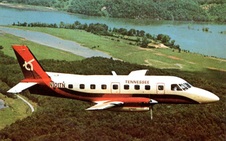
91
Tennessee Bandeirante #2
Tennessee Airways was launched in 1978, initially providing service between Knoxville, Nashville and Chattanooga. Lexington. Tri Cities, and Charlotte were added by 1981, and by 1984 Cincinnati, Memphis, and London/Corbin, Ky were served, although Memphis services lasted only 3 months.
| 
92
Tennessee EMB-110 #3 KCF
Early services were operated by Navajos, but by 1980, new Bandeirantes were replacing them.The airline survived until 1987. By then, services had been reduced to 4 cities, including Huntsville, Al. Some resources were deployed to Iowa for use on the short lived Iowa Airways. Card by courtesy of Kuo-Ching Fu.
| 
93
Tennessee Route Map
Tennessee was generous with postcards as there are at least 4 airline issues. This cartoon card with route map was issued in early 1985, when Tennessee was operating a route from Knoxville to Washington.
| 
94
Trans Central Metro #1
Trans Central was launched in 1980 with the purchase of Air Central, a Navajo operator from Enid OK. Four Metros as shown on the above airline issue were added in 1980. By 1981, routes reached Topeka, Dallas, Little Rock and Memphis.
| 
95
Trans Central Metro #2
Growth was steady and by 1983 2 new Metro IIIs were added and 10 cities were served. A new paint scheme was adopted for the new Metros, supposedly to reflect US Marine uniform colors.
|

96
Trans Central YS-11 #2 KCF
A bold step was taken in 1983, introducing 4 ex All Nippon YS-11s to the system, providing cabin service and comfort to the busier routes. The drain on financial resources imposed by the acquisition, as well as high maintenance on older Metros ultimately forced the airline to cease operations in September 1984.
| 
97
Wings Trislander # 1
Wings Was formed in 1977 to shuttle passengers from rural Philadelphia area airports to International. BN Trislanders were used, as well as Islanders. The airline expanded to Dover, Allentown, New York and Washington, adding a Twin Otter in 1986. Despite a successful 14 year service, new interstates impacted much of Wings' traffic, and the airline shut down in 1991. To my knowledge this was the only long term Trislander operation in the US. Card by courtesy of Kuo-Ching Fu.
| 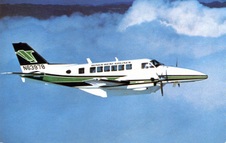
98
Wings West Beech 99
Wings West was a post deregulation entry in the California commuter market, launching in 1980 with Cessna 402s. New Beech C-99s were introduced in 1981, as shown on this Wings West issue, which operated until 1986.
| 
99
Wings West Metro #2
By 1985 the routes covered 13 California destinations from Eureka to LA. Swearingin Metro IIIs were operating as shown on this excellent Wings West issue. But in 1986 the airline became an American Eagle carrier, and was purchased by American a year later.
| |